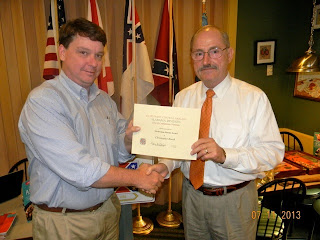 |
| Generals Pemberton and Grant in the VNMP Visitor Center |
The first stop on the bus tour was at a panoramic overlook of the battlefield where the Louisiana batteries stood along the five mile long front. The initial assault by Grant occurred down Graveyard Road on May 19, 1863 but the Union forces were repulsed. Another concerted attack was conducted on May 22nd all along the five mile front and this succeeded in destroying the Stockade Redan. A redan is a v-shaped earthen fortification approximately 8 feet wide and 7 feet deep. Again the Union troops were turned back and Grant decided his best recourse was to "outcamp" the Confederates and so began the siege. On June 26th, the 3rd Louisiana redan was blown up when tons of explosives were set in tunnels excavated under their redan positions along Logan's Approach. Trenches and the old Jackson Road are still visible although overgrown by grass. Trees have been removed over the past few years to return the landscape to reflect the terrain of the period 150 years ago.
 |
| The Louisiana Batteries Overlooking the Battlefield |
One of the first monuments constructed at the VNMP is the Illinois monument which has 47 steps from the road to the structure, one for each day of the siege. It is a beautiful impressive marble structure which would have cost approximately $45MM in today's dollars to build. Bronze plaques inside the building list Illinois veterans who fought at Vicksburg under Grant. Adjacent is the Shirley home which is the only structure on the property which dates to the period of the War. The dogtrot architecture house was owned by a lawyer and was used as part of the Union fortifications during the siege and was not destroyed only after his daughter raised a white flag surrendering the house telling the invading army that they were loyalists from New Hampshire.
 |
| The Interior of the Illinois Monument |
 |
| The Illinois Monument The Shirley House |
 |
| General Grant on Kangaroo |
The Union ironclads played a key role in the siege of Vicksburg and were successful in running supplies past the Confederate guns positioned on the bluffs overlooking the Mississippi. The U.S.S Cairo was an ironclad which was sunk on the Yazoo River, the first boat sunk using an electronic device in wartime, a galvanic charge detonating a mine. The vessel was raised from the bottom of the Yazoo in 1964 as were it's original guns and steam engine and paddlewheels which can be viewed in the exhibit housing the Cairo in the VNMP. The Cairo was one of seven identical gunboats used in the siege, all built in 100 days by the U.S. Navy. The massive steam engines powered the ships to a speed of 8 knots. The Cairo is the only surviving ironclad gunboat used in the siege. The Mississippi abruptly changed its course in 1876 and the Yazoo River actually fronts the city of Vicksburg today.
 | ||
| The U.S.S. Cairo The Cairo Torpedoed with Original Cannon
|
18000 veterans are buried in the VNMP including 17000 Union troops and two Confederates. The remaining graves are veterans of U.S. Wars since the War Between the States up to the Korean War. The Confederate and Union lines were about a half mile apart along the front. Pemberton's Confederates had around 175 artillery pieces while Grant's forces used about 140 guns. But the Union troops numbered 75000 to the 30000 Confederates holed up around Vicksburg. A cul-de-sac in the park is located at the spot where Pemberton and Grant met under an oak tree to discuss terms of the surrender on July 3rd. After pleasantries including reminiscing of their past at West Point, Grant demanded unconditional surrender but Pemberton refused and they retired to their lines. But Grant reconsidered with the recommendation from his junior officers that it would be logistically impossible to detain and transport so many prisoners and the Confederates were subsequently paroled after taking an oath of allegiance to the United States; nonetheless, many of these Confederate troops returned to service for the Cause and faced Grant's forces at later battles.
 |
| Cemetery at Vicksburg National Military Park |
The Mississippi monument is next to a statue of Pemberton and nearby is a statue of Jefferson Davis who had a home about 10 miles from Vicksburg. The Texas monument is on Railroad Redoubt where Texas troops drove out Union troops in hand-to-hand combat on May 22nd. The Union General subsequently failed to inform Grant of this loss and was relieved of duties and transferred to Washington DC. One of the last statues observed on the tour was of Confederate General Stephen Dill Lee who was also President of Mississippi State University and Commander in Chief of the United Confederate Veterans and first superintendent of the Vicksburg National Military Park. In 1917, a reunion of 10000 Union and Confederate veterans met at the park and the donated the funds which built the arch entry to the VNMP.



































